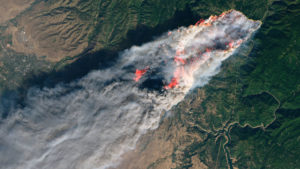2018 fourth costliest year on record for natural disasters
According to reinsurance company Swiss Re’s preliminary estimates, total global losses for natural and man-made disasters in 2018 amount to approximately USD $155 billion. Although that figure amounts to a little less than half of the price tag attached to 2017 losses, this estimate makes 2018 the fourth costliest year on record and higher than the annual average for the previous 10 years.

In terms of damages, the US had the top three costliest disasters in 2018. November’s Camp Fire, which decimated the town of Paradise, California and broke the record for California’s most destructive wildfire, was the most expensive disaster in 2018, causing $16.5 billion in damages. Hurricane Michael which nearly leveled Florida’s Mexico Beach, and Hurricane Florence which caused severe flooding in the Carolinas followed behind the Camp Fire with damages ringing in at $16 billion and $14 billion, respectively. Swiss Re reports that in 2018, insurance covered $79 billion in natural disaster damages, representing about half of all global losses.
Scientists maintain that climate change has a role in the increasing impact and severity of disasters. Hotter temperatures can exacerbate prolonged droughts which increase the risk of wildfires, strengthen hurricanes, and increase extreme rainfall events. The human impacts of a changing climate on the severity and frequency of disasters were outlined in reports from the International Panel on Climate Change and the US National Climate Assessment.
Disasters have also caused about 11,000 deaths in 2018, according to Swiss Re. The deadliest disaster in 2018 was the earthquake in Sulawesi, Indonesia in September, with approximately 3,500 people reported dead or missing. The top three deadliest natural disasters all occurred in Indonesia, which has suffered from a slew of earthquakes, volcanic activity, and tsunamis over the past year.
Swiss Re’s report asserts, “the losses from the 2018 series of events highlight the increasing vulnerability of the ever-growing concentration of humans and property values on coastlines and in the urban-wildlife interface.”
The human and capital costs incurred over the past year pinpoints the need for integrating resilience into disaster mitigation and management. As was stressed by the Global Resilience Institute’s 2017 Wildfire report, “Stakeholders located both inside and outside of [disaster]-prone areas must have the tools necessary to better analyze their interdependencies and the associated risk of cascading failures.” In the coming year, the Global Resilience Institute will continue in its interdisciplinary research that will help address this need, with the goal of helping systems, networks, infrastructure and communities adapt and prepare for disruptions of all kinds.
Sources and Further Readings
USA had world’s 3 costliest natural disasters in 2018, and Camp Fire was the worst – USA Today
Global Warming of 1.5ºC Special Report – International Panel on Climate Change
Fourth National Climate Assessment – U.S. Global Change Research Program
3 big takeaways from the diasasters that hammered the US in 2018 – VOX
Wildfire: A Changing Landscape – Global Resilience Institute & National Fire Protection Association
